SSC113e The Social Self: India's Dalits Still Fighting Untouchability
VerifiedAdded on 2023/06/08
|8
|2167
|281
Report
AI Summary
This report delves into the persistent issue of untouchability faced by Dalits in India, examining the sociological factors that perpetuate discrimination. It explores the historical context of the caste system, social stratification, and the impact on the lives of Dalits, including instances of discrimination in daily life. The report utilizes sociological theories, such as those of Cooley and Mead, to analyze the development of the social self within this context. It highlights the challenges Dalits face in accessing essential amenities, achieving social mobility, and receiving equal treatment under the law. The report also touches upon the role of situated identity and the influence of social class on perceptions and experiences. Through an analysis of real-life examples, the report emphasizes the need for societal change and the importance of support from both Dalits and non-Dalits to eliminate caste-based discrimination and promote equality.
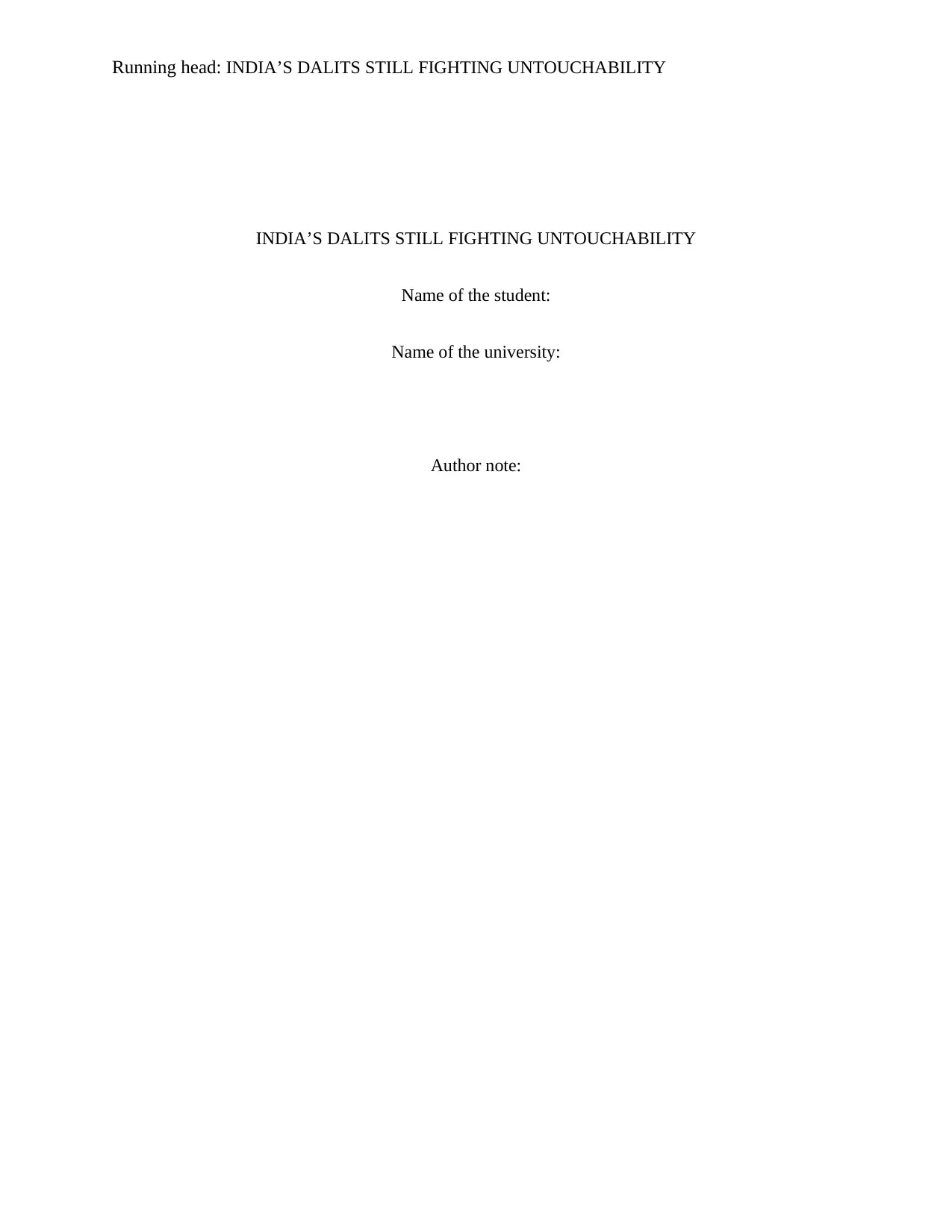
Running head: INDIA’S DALITS STILL FIGHTING UNTOUCHABILITY
INDIA’S DALITS STILL FIGHTING UNTOUCHABILITY
Name of the student:
Name of the university:
Author note:
INDIA’S DALITS STILL FIGHTING UNTOUCHABILITY
Name of the student:
Name of the university:
Author note:
Paraphrase This Document
Need a fresh take? Get an instant paraphrase of this document with our AI Paraphraser
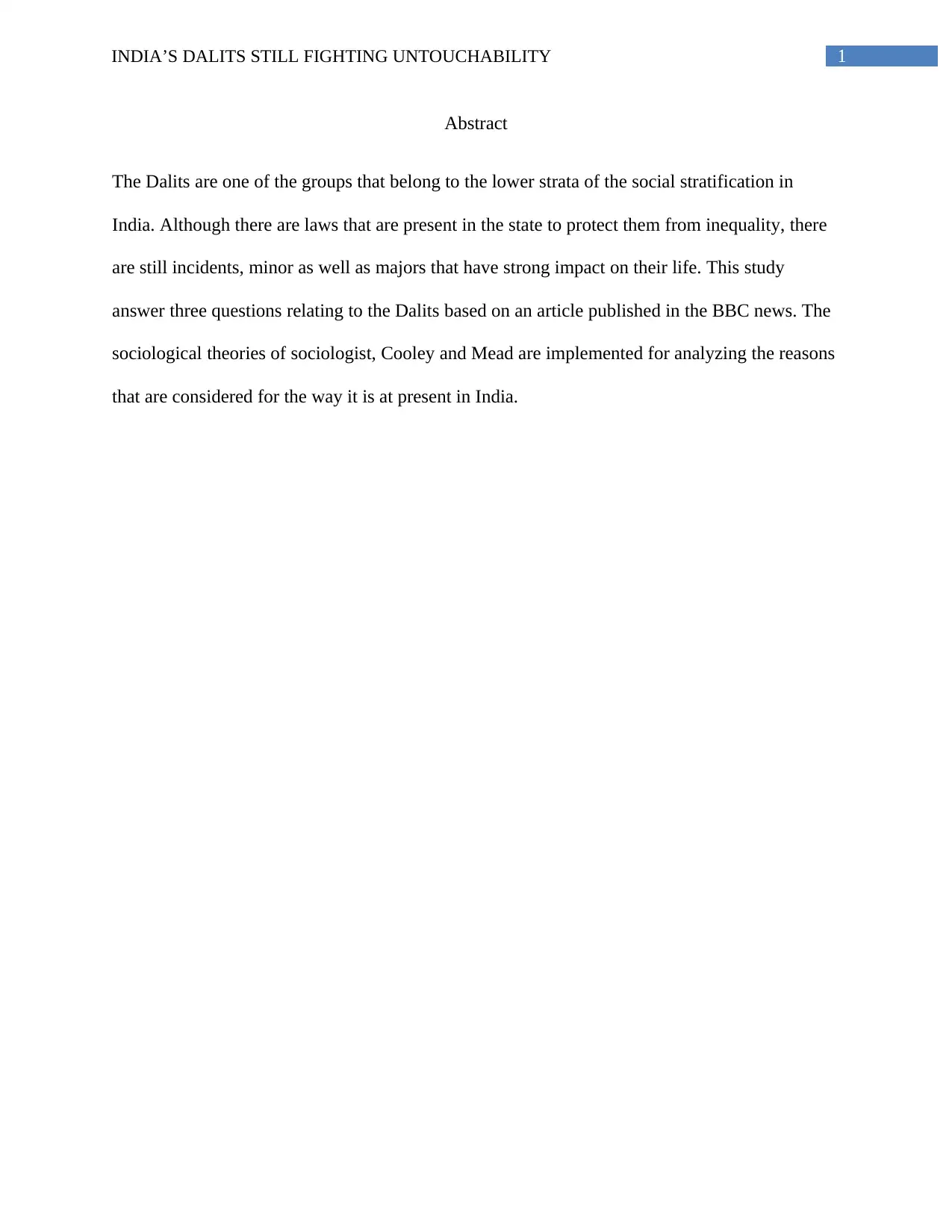
1INDIA’S DALITS STILL FIGHTING UNTOUCHABILITY
Abstract
The Dalits are one of the groups that belong to the lower strata of the social stratification in
India. Although there are laws that are present in the state to protect them from inequality, there
are still incidents, minor as well as majors that have strong impact on their life. This study
answer three questions relating to the Dalits based on an article published in the BBC news. The
sociological theories of sociologist, Cooley and Mead are implemented for analyzing the reasons
that are considered for the way it is at present in India.
Abstract
The Dalits are one of the groups that belong to the lower strata of the social stratification in
India. Although there are laws that are present in the state to protect them from inequality, there
are still incidents, minor as well as majors that have strong impact on their life. This study
answer three questions relating to the Dalits based on an article published in the BBC news. The
sociological theories of sociologist, Cooley and Mead are implemented for analyzing the reasons
that are considered for the way it is at present in India.

2INDIA’S DALITS STILL FIGHTING UNTOUCHABILITY
INDIA’S DALITS STILL FIGHTING UNTOUCHABILITY
a) Dalits are a social group that is considered to be the lowest group in the social
hierarchy system (John, 2017). In India, the caste system has been a deep-rooted problem,
especially among Hinduism. The social stratification of the society according to one’s social
position that a person is born with has been represented through the caste system (Agarwal,
2016). the caste system has remained a part of the Hindu society from a tedious time, and the
people are always found using it in their way. The Dalits being in the lowest position of the
social stratification has been through the worst experiences in India.
India is famous for its caste system and with legal laws present for the protection of the
lower caste people it is still evident in many rural places of India (Bhosale, 2015). The plight of
Dalits in India is worse since the Indian government is made up of the upper castes people who
have successfully convinced the international as a country where the caste system is only an
internal problem (Griffith-Jones, 2016). However, the truth is it lies in its every functional body.
According to Dr Sonkar’s thesis, India’s 15 per cent of the population is still kept on the margin
of the of society due to untouchability. Also, even after the ban on the practice of untouchability,
there are many such cases that display the unfair practice. Incidents such as, local barber refusing
to cut the hair of Dalits, Dalit children are forced to have lunch separately, Dalit women have to
walk miles away to fetch water, and many more are some common examples that show the
conditions of Dalits in India (Bach, 2015). In different rural places, Dalits are found struggling
with life for even essential amenities. They are always the victim of the upper class’
maltreatment. The laws fail to secure them, and due to the fact that there are no Dalit policemen,
Dalits are not helped by the police as well.
INDIA’S DALITS STILL FIGHTING UNTOUCHABILITY
a) Dalits are a social group that is considered to be the lowest group in the social
hierarchy system (John, 2017). In India, the caste system has been a deep-rooted problem,
especially among Hinduism. The social stratification of the society according to one’s social
position that a person is born with has been represented through the caste system (Agarwal,
2016). the caste system has remained a part of the Hindu society from a tedious time, and the
people are always found using it in their way. The Dalits being in the lowest position of the
social stratification has been through the worst experiences in India.
India is famous for its caste system and with legal laws present for the protection of the
lower caste people it is still evident in many rural places of India (Bhosale, 2015). The plight of
Dalits in India is worse since the Indian government is made up of the upper castes people who
have successfully convinced the international as a country where the caste system is only an
internal problem (Griffith-Jones, 2016). However, the truth is it lies in its every functional body.
According to Dr Sonkar’s thesis, India’s 15 per cent of the population is still kept on the margin
of the of society due to untouchability. Also, even after the ban on the practice of untouchability,
there are many such cases that display the unfair practice. Incidents such as, local barber refusing
to cut the hair of Dalits, Dalit children are forced to have lunch separately, Dalit women have to
walk miles away to fetch water, and many more are some common examples that show the
conditions of Dalits in India (Bach, 2015). In different rural places, Dalits are found struggling
with life for even essential amenities. They are always the victim of the upper class’
maltreatment. The laws fail to secure them, and due to the fact that there are no Dalit policemen,
Dalits are not helped by the police as well.
⊘ This is a preview!⊘
Do you want full access?
Subscribe today to unlock all pages.

Trusted by 1+ million students worldwide
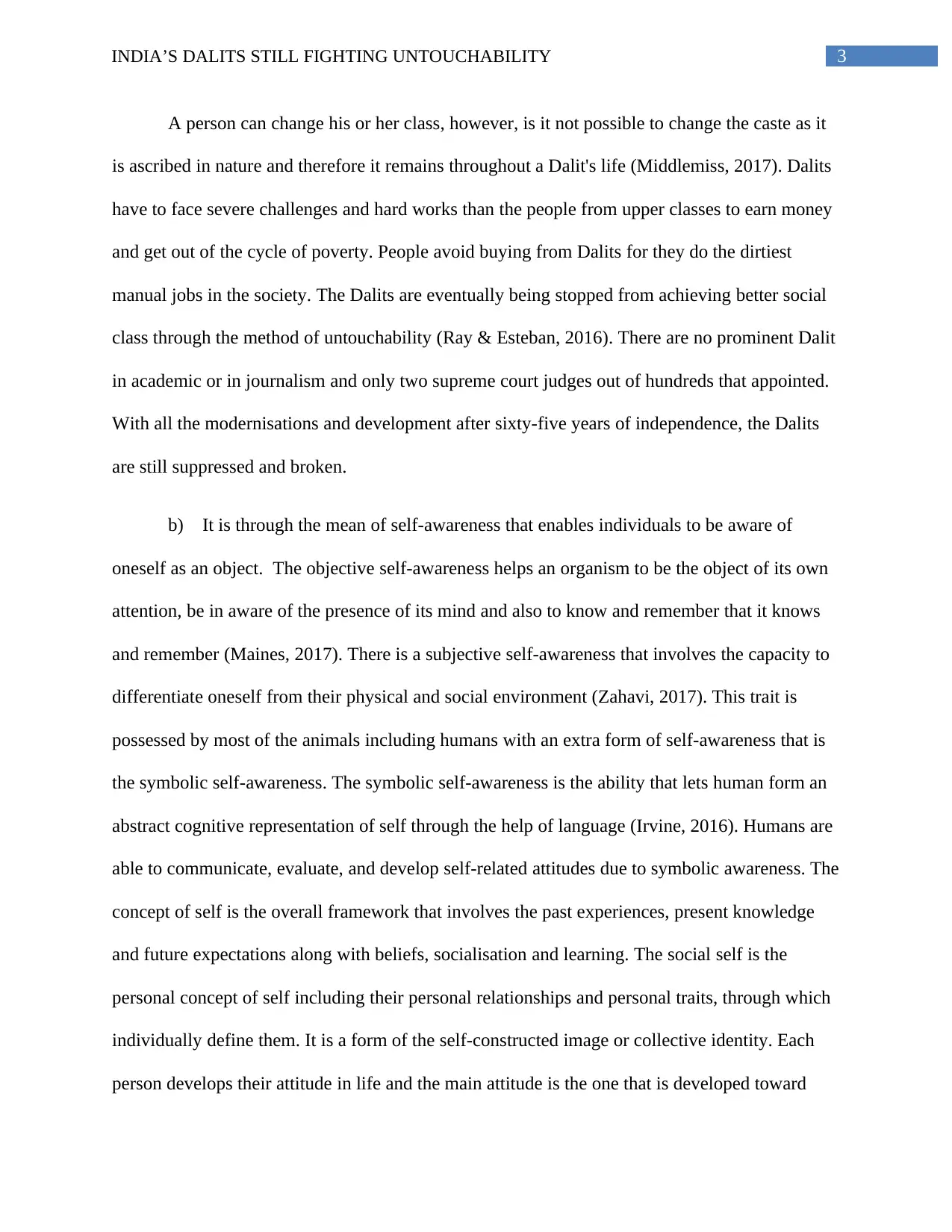
3INDIA’S DALITS STILL FIGHTING UNTOUCHABILITY
A person can change his or her class, however, is it not possible to change the caste as it
is ascribed in nature and therefore it remains throughout a Dalit's life (Middlemiss, 2017). Dalits
have to face severe challenges and hard works than the people from upper classes to earn money
and get out of the cycle of poverty. People avoid buying from Dalits for they do the dirtiest
manual jobs in the society. The Dalits are eventually being stopped from achieving better social
class through the method of untouchability (Ray & Esteban, 2016). There are no prominent Dalit
in academic or in journalism and only two supreme court judges out of hundreds that appointed.
With all the modernisations and development after sixty-five years of independence, the Dalits
are still suppressed and broken.
b) It is through the mean of self-awareness that enables individuals to be aware of
oneself as an object. The objective self-awareness helps an organism to be the object of its own
attention, be in aware of the presence of its mind and also to know and remember that it knows
and remember (Maines, 2017). There is a subjective self-awareness that involves the capacity to
differentiate oneself from their physical and social environment (Zahavi, 2017). This trait is
possessed by most of the animals including humans with an extra form of self-awareness that is
the symbolic self-awareness. The symbolic self-awareness is the ability that lets human form an
abstract cognitive representation of self through the help of language (Irvine, 2016). Humans are
able to communicate, evaluate, and develop self-related attitudes due to symbolic awareness. The
concept of self is the overall framework that involves the past experiences, present knowledge
and future expectations along with beliefs, socialisation and learning. The social self is the
personal concept of self including their personal relationships and personal traits, through which
individually define them. It is a form of the self-constructed image or collective identity. Each
person develops their attitude in life and the main attitude is the one that is developed toward
A person can change his or her class, however, is it not possible to change the caste as it
is ascribed in nature and therefore it remains throughout a Dalit's life (Middlemiss, 2017). Dalits
have to face severe challenges and hard works than the people from upper classes to earn money
and get out of the cycle of poverty. People avoid buying from Dalits for they do the dirtiest
manual jobs in the society. The Dalits are eventually being stopped from achieving better social
class through the method of untouchability (Ray & Esteban, 2016). There are no prominent Dalit
in academic or in journalism and only two supreme court judges out of hundreds that appointed.
With all the modernisations and development after sixty-five years of independence, the Dalits
are still suppressed and broken.
b) It is through the mean of self-awareness that enables individuals to be aware of
oneself as an object. The objective self-awareness helps an organism to be the object of its own
attention, be in aware of the presence of its mind and also to know and remember that it knows
and remember (Maines, 2017). There is a subjective self-awareness that involves the capacity to
differentiate oneself from their physical and social environment (Zahavi, 2017). This trait is
possessed by most of the animals including humans with an extra form of self-awareness that is
the symbolic self-awareness. The symbolic self-awareness is the ability that lets human form an
abstract cognitive representation of self through the help of language (Irvine, 2016). Humans are
able to communicate, evaluate, and develop self-related attitudes due to symbolic awareness. The
concept of self is the overall framework that involves the past experiences, present knowledge
and future expectations along with beliefs, socialisation and learning. The social self is the
personal concept of self including their personal relationships and personal traits, through which
individually define them. It is a form of the self-constructed image or collective identity. Each
person develops their attitude in life and the main attitude is the one that is developed toward
Paraphrase This Document
Need a fresh take? Get an instant paraphrase of this document with our AI Paraphraser

4INDIA’S DALITS STILL FIGHTING UNTOUCHABILITY
oneself. The value a person gives to oneself is the self-worth that the person thinks of himself,
this sense of self-worth is known as self-esteem (Cooley, 2017).
An identity that is based on the roles played by an individual is the situated identity.
Every situation demands a role that defines a social position in the situation (Hester & Housley,
2017). Playing the roles as per the situation helps in building social positions and Dalits have
been playing the part of the suppressed group under the upper caste people for a very long time
therefore at present, the situation of the Dalits have become constant that is hard to amend. The
social class works in society as an identity. Social class is related to the experience of privilege
as well as disadvantages based on their perception of social class. The Dalits are naturally seen
by the other group of people as the under privileged group due to its occupation.
People are often recognised by its group, Dalits are the group of people that belong to the
lower strata of the social hierarchy (Deshpande, 2017). The situation of Dalits is the
consequences of the situated identity of the group. The group is defined by the occupation it
plays in the society. When a child is born in the Dalit community, it is socialised in the way
where it starts accepting the unfair treatment and it builds its concepts of self and identity. There
are some who goes against the norms and their collective identity and show the trait of
individuality. The situated identity of the Dalits for years has been the role it has been playing in
society.
c) The article shows Dr Vinod Sonkar threw the glass on the wall and threw money on
the counter when he was asked to wash his glass after drinking tea. He was asked to do so as he
was a Dalit and the shopkeeper would not touch the glass after a Dalit uses it. There are many
people belonging to the community of Dalits who have worked hard to get out of poverty and
oneself. The value a person gives to oneself is the self-worth that the person thinks of himself,
this sense of self-worth is known as self-esteem (Cooley, 2017).
An identity that is based on the roles played by an individual is the situated identity.
Every situation demands a role that defines a social position in the situation (Hester & Housley,
2017). Playing the roles as per the situation helps in building social positions and Dalits have
been playing the part of the suppressed group under the upper caste people for a very long time
therefore at present, the situation of the Dalits have become constant that is hard to amend. The
social class works in society as an identity. Social class is related to the experience of privilege
as well as disadvantages based on their perception of social class. The Dalits are naturally seen
by the other group of people as the under privileged group due to its occupation.
People are often recognised by its group, Dalits are the group of people that belong to the
lower strata of the social hierarchy (Deshpande, 2017). The situation of Dalits is the
consequences of the situated identity of the group. The group is defined by the occupation it
plays in the society. When a child is born in the Dalit community, it is socialised in the way
where it starts accepting the unfair treatment and it builds its concepts of self and identity. There
are some who goes against the norms and their collective identity and show the trait of
individuality. The situated identity of the Dalits for years has been the role it has been playing in
society.
c) The article shows Dr Vinod Sonkar threw the glass on the wall and threw money on
the counter when he was asked to wash his glass after drinking tea. He was asked to do so as he
was a Dalit and the shopkeeper would not touch the glass after a Dalit uses it. There are many
people belonging to the community of Dalits who have worked hard to get out of poverty and
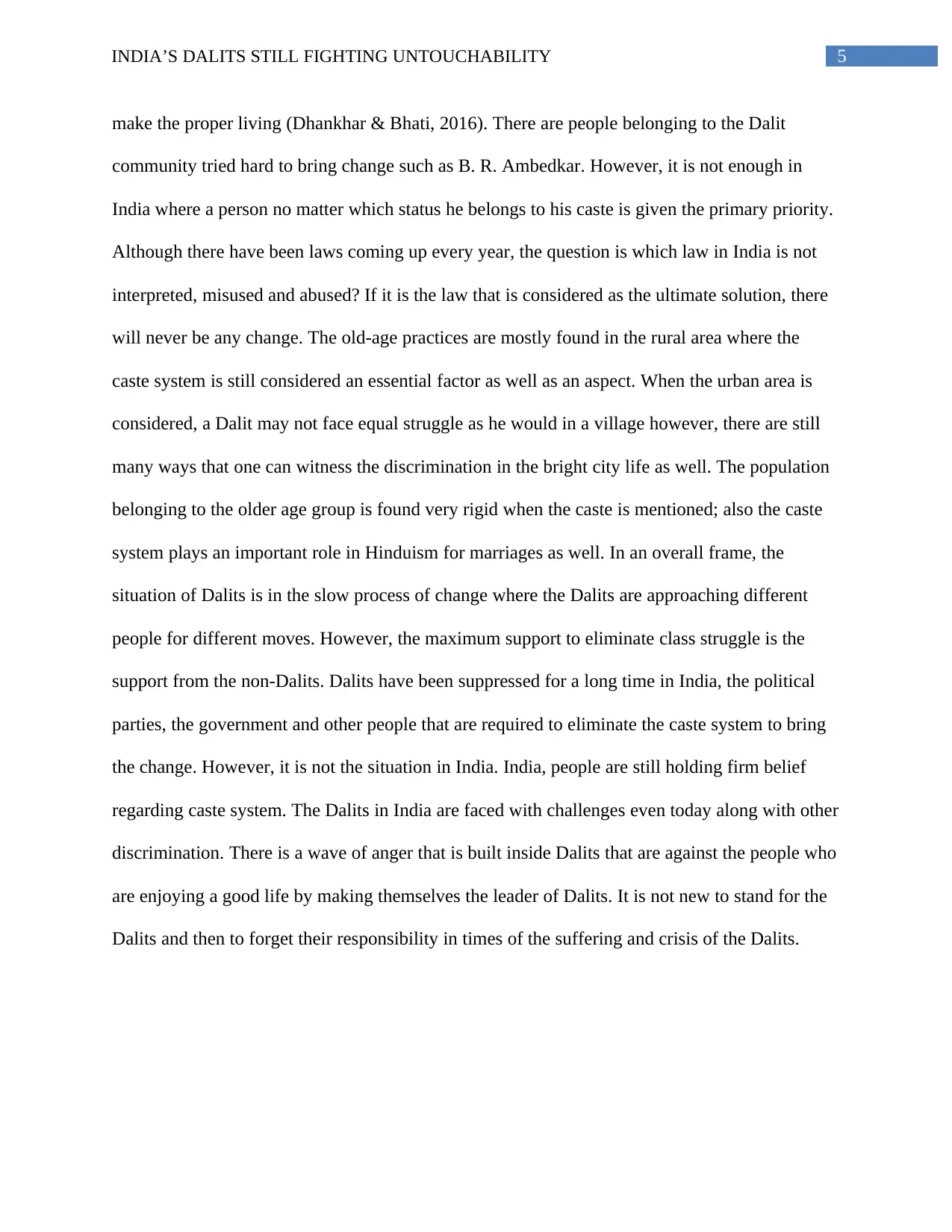
5INDIA’S DALITS STILL FIGHTING UNTOUCHABILITY
make the proper living (Dhankhar & Bhati, 2016). There are people belonging to the Dalit
community tried hard to bring change such as B. R. Ambedkar. However, it is not enough in
India where a person no matter which status he belongs to his caste is given the primary priority.
Although there have been laws coming up every year, the question is which law in India is not
interpreted, misused and abused? If it is the law that is considered as the ultimate solution, there
will never be any change. The old-age practices are mostly found in the rural area where the
caste system is still considered an essential factor as well as an aspect. When the urban area is
considered, a Dalit may not face equal struggle as he would in a village however, there are still
many ways that one can witness the discrimination in the bright city life as well. The population
belonging to the older age group is found very rigid when the caste is mentioned; also the caste
system plays an important role in Hinduism for marriages as well. In an overall frame, the
situation of Dalits is in the slow process of change where the Dalits are approaching different
people for different moves. However, the maximum support to eliminate class struggle is the
support from the non-Dalits. Dalits have been suppressed for a long time in India, the political
parties, the government and other people that are required to eliminate the caste system to bring
the change. However, it is not the situation in India. India, people are still holding firm belief
regarding caste system. The Dalits in India are faced with challenges even today along with other
discrimination. There is a wave of anger that is built inside Dalits that are against the people who
are enjoying a good life by making themselves the leader of Dalits. It is not new to stand for the
Dalits and then to forget their responsibility in times of the suffering and crisis of the Dalits.
make the proper living (Dhankhar & Bhati, 2016). There are people belonging to the Dalit
community tried hard to bring change such as B. R. Ambedkar. However, it is not enough in
India where a person no matter which status he belongs to his caste is given the primary priority.
Although there have been laws coming up every year, the question is which law in India is not
interpreted, misused and abused? If it is the law that is considered as the ultimate solution, there
will never be any change. The old-age practices are mostly found in the rural area where the
caste system is still considered an essential factor as well as an aspect. When the urban area is
considered, a Dalit may not face equal struggle as he would in a village however, there are still
many ways that one can witness the discrimination in the bright city life as well. The population
belonging to the older age group is found very rigid when the caste is mentioned; also the caste
system plays an important role in Hinduism for marriages as well. In an overall frame, the
situation of Dalits is in the slow process of change where the Dalits are approaching different
people for different moves. However, the maximum support to eliminate class struggle is the
support from the non-Dalits. Dalits have been suppressed for a long time in India, the political
parties, the government and other people that are required to eliminate the caste system to bring
the change. However, it is not the situation in India. India, people are still holding firm belief
regarding caste system. The Dalits in India are faced with challenges even today along with other
discrimination. There is a wave of anger that is built inside Dalits that are against the people who
are enjoying a good life by making themselves the leader of Dalits. It is not new to stand for the
Dalits and then to forget their responsibility in times of the suffering and crisis of the Dalits.
⊘ This is a preview!⊘
Do you want full access?
Subscribe today to unlock all pages.

Trusted by 1+ million students worldwide
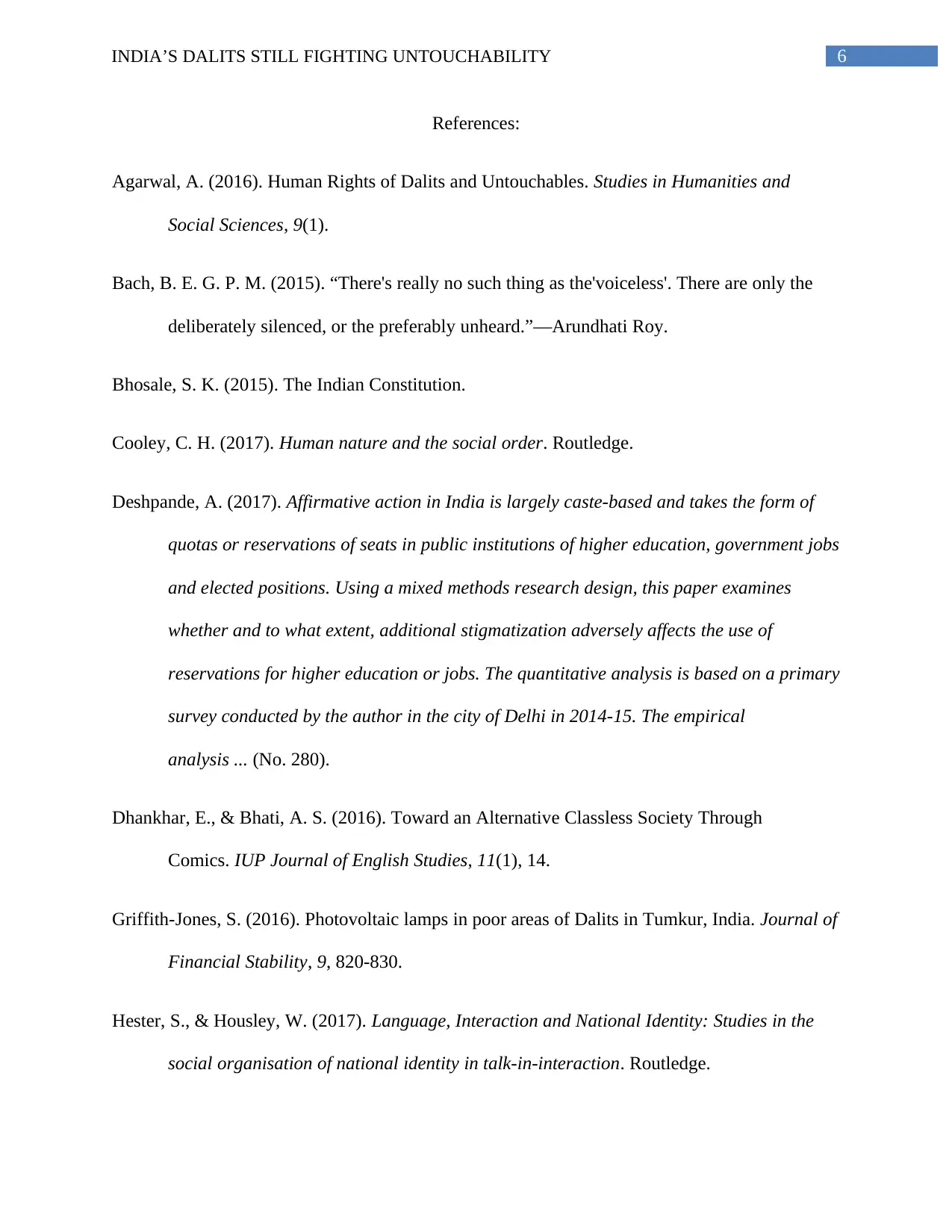
6INDIA’S DALITS STILL FIGHTING UNTOUCHABILITY
References:
Agarwal, A. (2016). Human Rights of Dalits and Untouchables. Studies in Humanities and
Social Sciences, 9(1).
Bach, B. E. G. P. M. (2015). “There's really no such thing as the'voiceless'. There are only the
deliberately silenced, or the preferably unheard.”―Arundhati Roy.
Bhosale, S. K. (2015). The Indian Constitution.
Cooley, C. H. (2017). Human nature and the social order. Routledge.
Deshpande, A. (2017). Affirmative action in India is largely caste-based and takes the form of
quotas or reservations of seats in public institutions of higher education, government jobs
and elected positions. Using a mixed methods research design, this paper examines
whether and to what extent, additional stigmatization adversely affects the use of
reservations for higher education or jobs. The quantitative analysis is based on a primary
survey conducted by the author in the city of Delhi in 2014-15. The empirical
analysis ... (No. 280).
Dhankhar, E., & Bhati, A. S. (2016). Toward an Alternative Classless Society Through
Comics. IUP Journal of English Studies, 11(1), 14.
Griffith-Jones, S. (2016). Photovoltaic lamps in poor areas of Dalits in Tumkur, India. Journal of
Financial Stability, 9, 820-830.
Hester, S., & Housley, W. (2017). Language, Interaction and National Identity: Studies in the
social organisation of national identity in talk-in-interaction. Routledge.
References:
Agarwal, A. (2016). Human Rights of Dalits and Untouchables. Studies in Humanities and
Social Sciences, 9(1).
Bach, B. E. G. P. M. (2015). “There's really no such thing as the'voiceless'. There are only the
deliberately silenced, or the preferably unheard.”―Arundhati Roy.
Bhosale, S. K. (2015). The Indian Constitution.
Cooley, C. H. (2017). Human nature and the social order. Routledge.
Deshpande, A. (2017). Affirmative action in India is largely caste-based and takes the form of
quotas or reservations of seats in public institutions of higher education, government jobs
and elected positions. Using a mixed methods research design, this paper examines
whether and to what extent, additional stigmatization adversely affects the use of
reservations for higher education or jobs. The quantitative analysis is based on a primary
survey conducted by the author in the city of Delhi in 2014-15. The empirical
analysis ... (No. 280).
Dhankhar, E., & Bhati, A. S. (2016). Toward an Alternative Classless Society Through
Comics. IUP Journal of English Studies, 11(1), 14.
Griffith-Jones, S. (2016). Photovoltaic lamps in poor areas of Dalits in Tumkur, India. Journal of
Financial Stability, 9, 820-830.
Hester, S., & Housley, W. (2017). Language, Interaction and National Identity: Studies in the
social organisation of national identity in talk-in-interaction. Routledge.
Paraphrase This Document
Need a fresh take? Get an instant paraphrase of this document with our AI Paraphraser
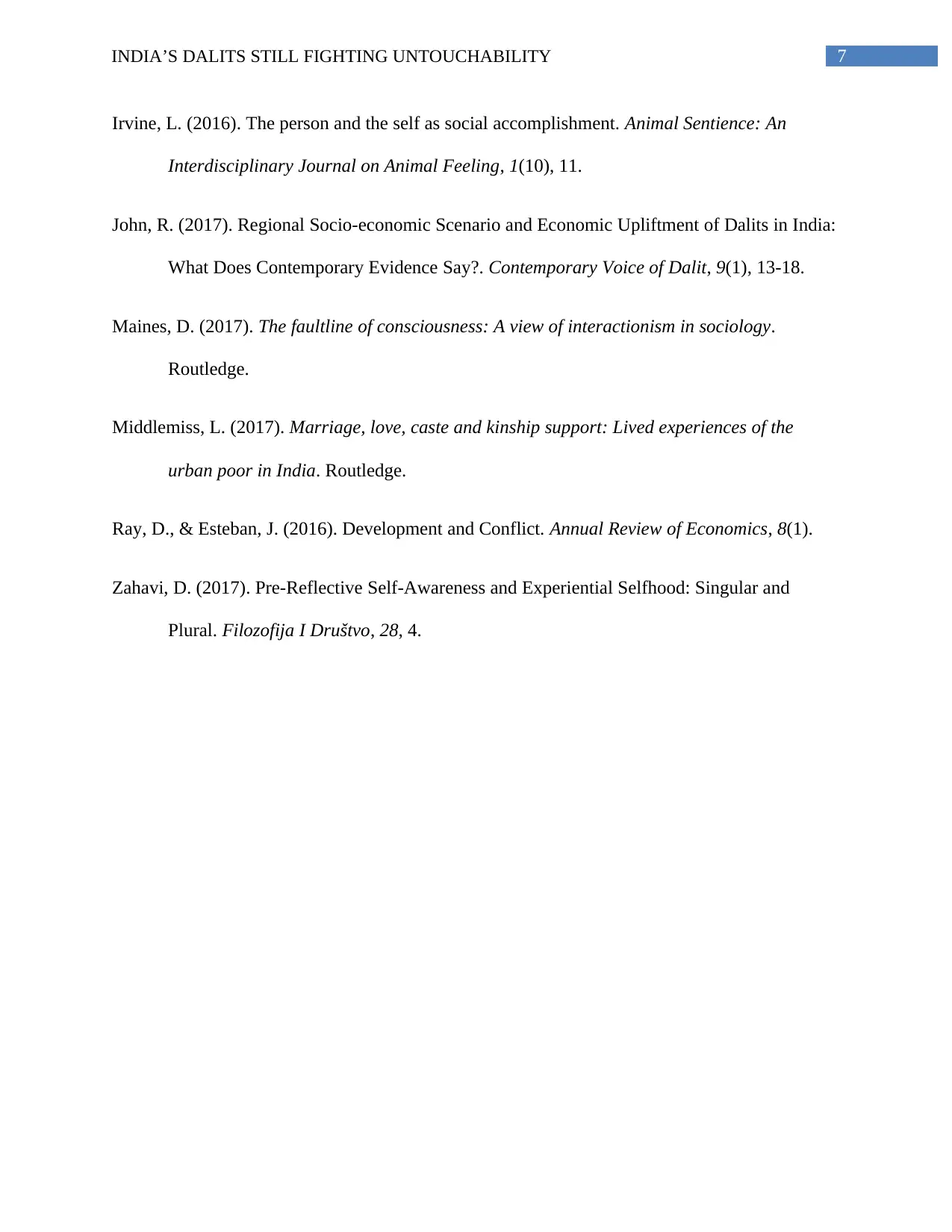
7INDIA’S DALITS STILL FIGHTING UNTOUCHABILITY
Irvine, L. (2016). The person and the self as social accomplishment. Animal Sentience: An
Interdisciplinary Journal on Animal Feeling, 1(10), 11.
John, R. (2017). Regional Socio-economic Scenario and Economic Upliftment of Dalits in India:
What Does Contemporary Evidence Say?. Contemporary Voice of Dalit, 9(1), 13-18.
Maines, D. (2017). The faultline of consciousness: A view of interactionism in sociology.
Routledge.
Middlemiss, L. (2017). Marriage, love, caste and kinship support: Lived experiences of the
urban poor in India. Routledge.
Ray, D., & Esteban, J. (2016). Development and Conflict. Annual Review of Economics, 8(1).
Zahavi, D. (2017). Pre-Reflective Self-Awareness and Experiential Selfhood: Singular and
Plural. Filozofija I Društvo, 28, 4.
Irvine, L. (2016). The person and the self as social accomplishment. Animal Sentience: An
Interdisciplinary Journal on Animal Feeling, 1(10), 11.
John, R. (2017). Regional Socio-economic Scenario and Economic Upliftment of Dalits in India:
What Does Contemporary Evidence Say?. Contemporary Voice of Dalit, 9(1), 13-18.
Maines, D. (2017). The faultline of consciousness: A view of interactionism in sociology.
Routledge.
Middlemiss, L. (2017). Marriage, love, caste and kinship support: Lived experiences of the
urban poor in India. Routledge.
Ray, D., & Esteban, J. (2016). Development and Conflict. Annual Review of Economics, 8(1).
Zahavi, D. (2017). Pre-Reflective Self-Awareness and Experiential Selfhood: Singular and
Plural. Filozofija I Društvo, 28, 4.
1 out of 8
Related Documents
Your All-in-One AI-Powered Toolkit for Academic Success.
+13062052269
info@desklib.com
Available 24*7 on WhatsApp / Email
![[object Object]](/_next/static/media/star-bottom.7253800d.svg)
Unlock your academic potential
Copyright © 2020–2025 A2Z Services. All Rights Reserved. Developed and managed by ZUCOL.





